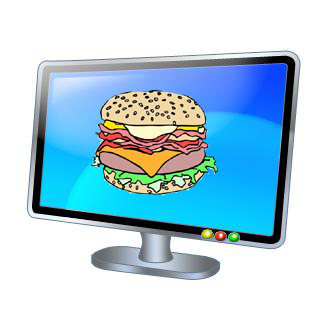Subliminal Seduction: How We Are Seduced And How Weight Loss Suffers
SUBLIMINAL SEDUCTION:
HOW WE ARE SEDUCED AND HOW WEIGHT LOSS SUFFERS (Issue 17)
by Diane Gold
Before we talk about the myriad of times per day we are seduced by advertising, let’s go to the dictionary. Subliminal seduction is a type of allure that takes place covertly, not behind closed doors, but without being overt like a male peacock displaying his feathers to a female, under our awareness.
The word, subliminal, means stimulating below the threshold of consciousness but able to register a response. We could think of it as planting a seed in our mind that continues to grow, even though we don’t see it. The word, seduction, means persuasion and enticement.
Let’s ask ourselves how many times a day we are subliminally seduced? And how often does this happen to our children, our teens.
As kids, we watch TV and, through the programs we watch, we are seduced into wanting clothing, body art, toys, homes and FOOD that we see on TV. Since broadcast services are changing, a lot of advertising is focused on mobile devices.
 With TV, if we can’t fast forward past it, we wait for a commercial to be over to watch the rest of our program and, even though we are multi-tasking on our computer, phone, tablet during the commercial; some of the marketing message aimed at us about some mouth-watering food, bathed in high fat (that clogs arteries), oil devoid of the good stuff (essential fatty acids and antioxidants) and very processed sugar (which always contains high calories and, when processed, offers no nutritional value) reaches us and, the next day, we want this very item when we are at the mall, coming home from sports or school.
With TV, if we can’t fast forward past it, we wait for a commercial to be over to watch the rest of our program and, even though we are multi-tasking on our computer, phone, tablet during the commercial; some of the marketing message aimed at us about some mouth-watering food, bathed in high fat (that clogs arteries), oil devoid of the good stuff (essential fatty acids and antioxidants) and very processed sugar (which always contains high calories and, when processed, offers no nutritional value) reaches us and, the next day, we want this very item when we are at the mall, coming home from sports or school.
Or, if we are teens, depending upon where we live, we can get off the school bus or drive ourselves to buy this treat ourselves with our lunch money, our savings from our summer job, or from money from not working anywhere because we get an allowance from our parents. We don’t realize this urge came from the commercial during last night’s TV show or the ad that came on when we were looking up something for our school assignment on our computer. And we learn this craving behavior for items that may not be healthy.
As adults, how many drug commercials do we see that are not relevant to us? So how is it that, when a friend talks about sleeplessness, we recite the name of some sleep drug whose commercial we thought we didn’t watch. Or when we have a back pain, we remember a sparkly celebrity associated with the drug whose commercial we didn’t think we watched, and we go out and buy the very brand the celebrity pitched because the celebrity is shiny and knows how to act. And then we get hungry from the back pain medicine, and we crave some of the food on the billboard down the block. Even though it is not on our diet plan.
 Then there are the friendly fast food restaurants that have built a culture around our ignorance. We were pulled in by the special toys they give away and our belief that, if there are 5 major companies advertising sugar cereal for our kids, it must be good for them. Or if there are 6 major companies all competing for the burgers, fries and drinks market; they all must have studied the nutrition behind the food and it must be healthy and safe for us as consumers. After all, they all have salads, now, so that would make for a balanced meal. And the FDA wouldn’t allow them to be in business if their food was no good.
Then there are the friendly fast food restaurants that have built a culture around our ignorance. We were pulled in by the special toys they give away and our belief that, if there are 5 major companies advertising sugar cereal for our kids, it must be good for them. Or if there are 6 major companies all competing for the burgers, fries and drinks market; they all must have studied the nutrition behind the food and it must be healthy and safe for us as consumers. After all, they all have salads, now, so that would make for a balanced meal. And the FDA wouldn’t allow them to be in business if their food was no good.
Seeing diverse cultures with perfect smiles portraying highly manicured magical food that came from a company that made donations to charity convinced us, until not too long ago, that fast food was part of our American dream and couldn’t be dangerous. In the past 20 years, although food labeling (one of my studies) has not changed much in 40 years; we know that being bombarded with advertising convinces us of falsehoods. Internet advertising actually follows us around online based upon our previous search patterns, buying patterns and demographics including age of our kids. These ads can appear in the form of banners on top in the header, flashing ads on the side, video clips that automatically start playing or just plain text. There’s so much visual noise that we probably don’t realize we are being bombarded.
If it’s creative, glitzy and has flash and bang; it builds brand loyalty. More than half of us don’t realize we buy many of our products based upon whose face is on the product or what happy feeling we associate the product with. We also like feeling wise about knowledge departmemt. We forget to care that we might have been enticed or educated through subliminal seduction and that our knowledge could be tainted with the deception that goes with ad campaigns.
When I was a kid, there were glamorous commercials and ads with big celebrities advertising cigarettes. We wanted to be like these celebrities, so it is fair to say that we were directly influenced to smoke by glamourous, subliminal TV and newpaper ads. Of course, it was found that the ads caused us to smoke. The ban on tobacco advertising came in 1971; the Surgeon General’s tobacco warning was required in 1984.
When my children were very young, there was a very successful multi-national fast food chain that began a monumental advertising campaign that continues today. This company spent massive amounts of money on tantalizing, musically catchy persuasion to show off their food. Of course, that’s what an ad campaign is supposed to do, seduce us. The ads that were on billboards and in newspapers were overt.
The much larger and more damaging subliminal part is (and I say is because it continues today) that we, the consumers, are given an entire mis-education whereby we learn that food is good if commercials are pretty, because the companies align themselves with special charities that help sick children, because they serve not one but 5 kinds of salads, so how could we not trust them to maximize this food with nutrition and safety?
One of our biggest failures today is that commerce has been allowed to develop without regard for the health and welfare of its consumers. We trust that, when our government agency puts a stamp of approval on food or drugs, we can trust that the research and testing that has gone on will keep us safe and well. Sadly, this is not the case.
So, what can we do for ourselves right now?
As always, we have a special action step that will be fun and helpful. We have a survey for you. If you are a mom (dad) reading this, share this survey with your daughter (or son) or do it together. We would like to hear your input. This should take no more than 10 minutes to do and there’s one secret solution to curbing the food urge that is fantastic and proven to work.
ACTION STEP: TAKE THE SURVEY HERE
http:/warriorsofweight.com/survey1
CONCLUSION
Subliminal Seduction is everywhere. Once we realize that point, we can begin to utilize it to our benefit. All we have to do is notice ourselves a little more closely. If we look at some of the outside influences that make us want to eat or go and eat; and if we use that one step in the survey; we may reach and maintain our goals more quickly.
It’s easy to be influenced if we are not paying attention. All we have to do is be observant.
FEEDBACK
We value your feedback. Please leave your comments below and twitter us @warriorsoweight.
______
DIANE GOLD, AUTHOR
Diane Gold, Founder of Warriors of Weight, Moms For Healthy Daughters, is a mentor in tai chi, kung fu and meditation, a music and stress expert and a dedicated mom. She believes that, when we can learn a greater awareness if we put in a little effort. She says, “The secret formula is to put in a little time every day. A few minutes daily makes a huge difference.”








[…] Subliminal Seduction: How We Are Seduced And How Weight Loss Suffers […]